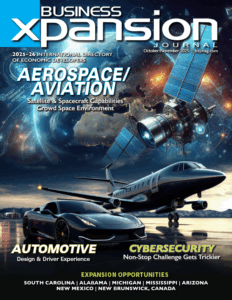
Wisconsin: Competing Nationally & Globally
23 Aug, 2017
A successful combination of location, skilled workforce, commitment to cutting-edge research, and favorable business policies and initiatives make a strong economy for Wisconsin.
With $2 billion in tax relief, including tax credits that almost eliminate the tax burden on manufacturers and agricultural producers, the economic climate of the state is allowing businesses to compete nationally and globally.
The state has invested $110 million in workforce training, and businesses and supporting organizations work together to advance industry innovation. Newly established centers of excellence in water research and energy technology are targeting the challenges of sustainable resource management. Academic institutions and public-private collaboration support a range of sciences including biotechnology, health care and food production.
The Wisconsin university system, anchored by the University of Wisconsin−Madison, supports the researchers, companies and policy-makers across the state that are working to develop solutions to the world’s challenges in water technology, bioscience, medical technology, information technology, and energy, power and control.
A cluster of Wisconsin manufacturers specializes in supplying equipment, parts and services to the aerospace sector, and the state is home to cutting-edge research and development in nanotechnology, engineering, power and control systems, and composite materials.
Wisconsin Regional Sidebars
By Rachel Hamilton
Madison Region
Information technology and life sciences are probably the industries seeing the largest growth in Madison, a “surge [which can be] traced back to the University of Wisconsin, Madison [UWM]” says Paul Jadin, president of the Madison Regional Economic Partnership (MadREP).
Life sciences companies in the Madison area are working on a diverse range of R&D and production — from cancer treatments to stem cell research to synthetic skin grafts, according to Jadin.
IT in the area is also tied to medicine because of Epic Systems, which specializes in healthcare-related software. “Epic is now approaching 10,000 employees. A lot of the talent coming to [work there originally] are starting their own businesses or going into local firms,” says Jadin.
“Game development is huge,” Jadin adds, noting that the area is hosting its first video game development conference, called M-Dev, in October of this year.
UWM’s Center for Dairy Research supports the legacy industry of dairy and agriculture in Wisconsin. “Agriculture continues to be a staple,” Jadin says. “We’re seeing an awful lot of growth from our specialty cheeses.”
“Our fourth strong sector is manufacturing. We do very well with agricultural equipment and medical equipment,” says Jadin. GE Healthcare’s Life Care Solutions produces anesthesia machines in Madison on a large scale.
“When it comes to talent, I think we’re in a strong position to attract both people and companies,” Jadin says, explaining that UMW’s educational offerings, a younger population and a nationally ranked business incubator all contribute to Madison’s competitive edge.
“Madison represents the alternative to those regions that you think of as powerhouses of IT and life science,” says Jadin, noting Madison’s ability to compete with Seattle, Denver, Austin or San Francisco, while at the same time offering a lower cost of living.
City of Fitchburg
Fitchburg, which encompasses about 35 square miles, is just south of Madison and included in MadREP’s territory, according to Michael Zimmerman, economic development director for the city.
Much of Fitchburg’s growth is in expansions of its existing businesses. This spring, Sub-Zero and Wolf Appliances moved into a 435,000 square-foot facility and expects completion of its 6,000 square-foot training center in the fall of 2017, says Zimmerman.
This expansion will bring about 1.5 million square feet under one roof on their Fitchburg campus and add roughly 300 jobs. MadREP and Fitchburg, Zimmerman says, pulled together about $1 million in infrastructure grants to help keep Sub-Zero in Fitchburg.
“One thing about us is we have a great diversity of industry clusters here,” says Zimmerman. Biotechnology, advanced manufacturing, information technology and instrumentation companies all have a place in Fitchburg — Promega Corp., Saris Cycling Group and Cameca Instruments Inc. are all strong examples.
“One of the economic drivers we’ve benefited from is Epic,” says Zimmerman, who estimates that about 1,100 of Epic’s roughly 10,000 employees live in Fitchburg.
Epic and other science and technology companies, he says, have improved the purchasing power of the region’s workforce, fueling growth in multifamily housing, restaurants and retail space — as well as the construction industry.
Fitchburg does have one of the lowest unemployment rates in the nation, but the University of Wisconsin in Madison and Fitchburg’s amenities make it attractive to talent, according to Zimmerman.
“Five of the state cycling trails are in Fitchburg,” says Zimmerman. “While these state trails offer significant recreation opportunities, because of their accessibility, they also provide commuter routes for our active workforce.”
Related Posts
-

Business Starts Here
-

TEXAS ENTERS 2021 AS WORLD’S 9TH LARGEST ECONOMY BY GDP
-

CALIFORNIA: 5TH LARGEST ECONOMY IN THE WORLD
-

MINNESOTA: FIRST IN FIVE-YEAR BUSINESS SURVIVAL RATE
-

CANADA: Alberta. More Open Than Ever
-

KENTUCKY: The Bluegrass State Is The Right Place To Grow Your Business
-

TENNESSEE: Great Brands Deserve the Great State of Tennessee
-

LOUISIANA: Custom Workforce for Expanding
-

MARYLAND: Home of Innovators
-

MAINE: Yankee Ingenuity










